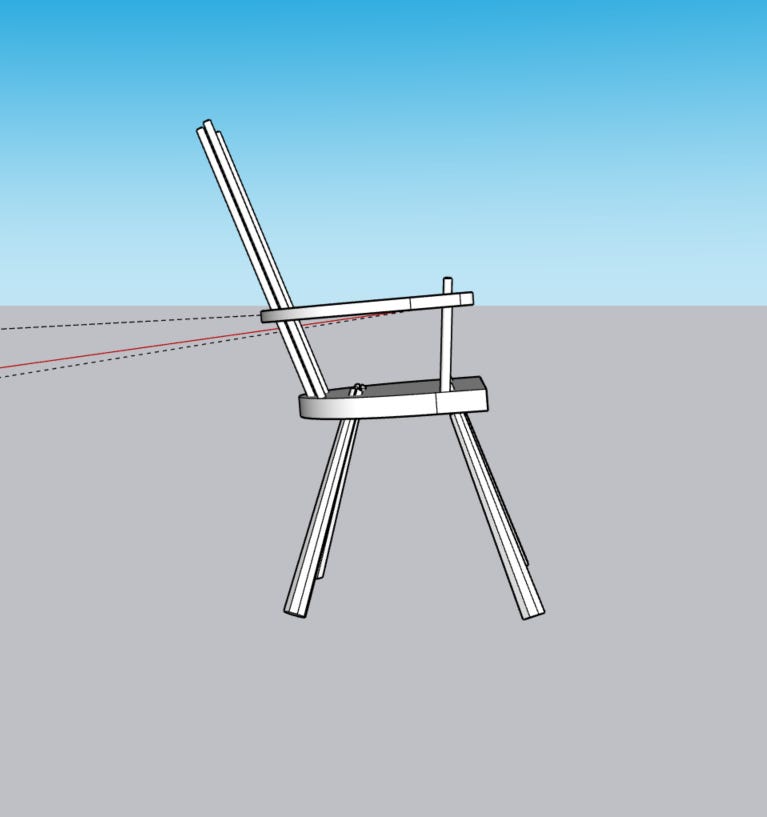I was so proud of myself for learning SketchUp well enough to model some future chairs. If you read my earlier post, it wasn’t an easy journey. My poor wife had to listen to me mutter and sputter and threaten the program a few times (okay, many times) while I figured out how to draw, extrude, move, rotate, and build in the program. Then she had to listen to me and applaud every time I showed her something that I did correctly (she’s an elementary school teacher so she’s used to giving out praise for small achievements).
As I modeled though, I felt myself getting pulled into the “need for perfection”. It was the voices in my head telling me that the long sticks weren’t perfectly spaced (haven’t figured out the array function quite yet), that the back legs might not be in the correct position, or that I needed to write down every little bit of detail from the rendering so I could build the chair exactly how I had sketched it.
Thankfully, a louder voice screamed “STOP IT, YOU IDIOT!” and I snapped back to reality and the reason why I learned SketchUp. I learned it because I wanted to use it to verify some numbers, some angles, and to get an idea of a concept before starting. I didn’t mean for it to be something that constricts my building, to create a set of plans to follow, or for me to worry about exactness. To do so, goes against the vernacular nature of this type of chair that was built by everyday people who needed a place to sit or wanted to make some extra money during the winter or slow season. They weren’t built by professional chairmakers with a set of plans, designated models, or as a set. They were one-offs built as experience, creativity, or the material dictated.
Even with other furniture, we’ve been cautioned to not blindly follow a set of plans, cut lists, and sketches but to measure as we go and to use our creativity and skills to make the piece our own. Many of my students get frustrated that their projects don’t look exactly like the plans or the pictures and then look at me strangely when I applaud them.
I’ve built one chair entirely from a set of plans. It was my first one. And it was suggested to use them so I wasn’t worried about the placement, angles, and measurements of everything but to focus on the skills and concept of chairmaking. To learn how to make tenons. To learn how to drill at a compound angle. To learn how to use a sightline and resultant angle to create rake and splay.
After that first chair, I use templates and measurements to help me build but they’re pulled from different chairs and everything is adjusted from start to finish. Nothing is just copied or traced. This isn’t to brag or show off but to suggest that templates and plans do have a place in building but I don’t want them or my SketchUp drawings restricting me.

The secondary reason that I learned SketchUp was that it can be a great teaching tool for my students to see measurements, angles, ratios,... manipulated in CAD for any project without having to build and fill my shop full of examples. And it’s something that the students can do at home if they have a decent computer and some patience. SketchUp has a free version and a reduced cost version for students.
“Hey Josiah, why don’t you have the students sketch it on paper?”
Good question. I do have them sketch on paper some. We’ll do a couple of sketches of small pieces of furniture. We’ll do a basic tiny home house plan. We’ll do the elevation views for it. It isn’t anything too fancy. The goal is to bring awareness and introduce drafting. We have a full drafting class in our technical center and I take my students down there to see that side of construction. CAD software’s ability to rotate the drawing, fix mistakes (fairly) easily, and create multiple renditions (fairly) easily without erasing and/or going through a bunch of paper is great but I also feel like hand drawing is a great skill to have. A couple of chairs that I’ve built have started from quick sketches in a notebook.
And no, I’m not knocking the CNC crowd. I have friends who do CNC work and they make some amazing pieces. If that’s your thing, go for it and enjoy it. My concept of SketchUp would be greatly different if I did CNC work. But I don’t, so it’s used as an aid.
** Side note: If anyone wants a copy of the renderings of the stick chair pieces, please let me know. I’ll give them to you for free as long as you don’t make fun of me for them… **




I’ve really wanted to learn sketch up since it feels like a handy thing to know. Your use case for chairs is great. I still don’t have a great mental picture of what X rake and Y splay should look like, let alone modifying mortise locations to fit legs under the seat etc.